Notes: Carham may have been a relatively insignificant station, but it can make claims that few other stations can. It is the title of a chapter in A J Mullay Rails across the Border (1990) although there is only a brief description of the station itself. Carham was one of only a handful of stations in Great Britain to be in one country but named after a settlement in another; the station is in Roxburgh, Scotland by a mere 200yd, but the village of Carham is in Northumberland, England. It was also a rare example of a station built in Scotland by an English railway company (the York, Berwick & Newcastle, a constituent of the North Eastern Railway) whilst over 40 stations in England were on lines of the Scottish companies, the North British Railway (including Berwick, Rothbury, Longtown and Silloth) and the Caledonian Railway. To add another anomaly, the parish of Carham’s only station was Sunilaws whilst Carham station was in the parish of Sprouston.
 The exact opening date of Carham station is not known. Early railway timetables sometimes failed to identify each station on a route, and Bradshaw of March 1850 gives the train service between ‘Sprouston (Kelso)’ and Tweedmouth in a narrative form with only the times of departure from the two termini stated and no reference to Carham or any other intermediate stations. Departures from Sprouston on weekdays are at 1.15am (stated as 1¼ morn.) – surely a mistake? – and at 2.45 and 6.20pm. On Sunday there are departures at 9.00am and 7.00pm. Quick (2009) suggests that the station opened with the line or very soon after. The exact opening date of Carham station is not known. Early railway timetables sometimes failed to identify each station on a route, and Bradshaw of March 1850 gives the train service between ‘Sprouston (Kelso)’ and Tweedmouth in a narrative form with only the times of departure from the two termini stated and no reference to Carham or any other intermediate stations. Departures from Sprouston on weekdays are at 1.15am (stated as 1¼ morn.) – surely a mistake? – and at 2.45 and 6.20pm. On Sunday there are departures at 9.00am and 7.00pm. Quick (2009) suggests that the station opened with the line or very soon after.
Carham station, like its neighbour Sunilaws, had staggered platforms, one either side of the level crossing – although at Carham the up platform was north-east of the crossing and the down to the south-west, the opposite of the arrangement at Sunilaws. Both platforms were 93yd in length. The stationmaster’s house was possibly designed by John and Benjamin Green. These architects created the series of wonderful station buildings on the East Coast main line (ECML) in Northumberland, some of which survive today, but their brief was to be less ambitious when the Kelso Branch station designs were commissioned. The buildings at Carham and Sunilaws were almost alike.
 The stationmaster’s house was on the up side, close to the crossing. The platform ramp was set back from the crossing and in front of the house there was a track-level path from the level crossing to the platform. The two-storey house was of smooth but uncoursed stone, with a dormer window facing the platform, adjoined to the south-west by a taller building of simpler design. One house was possibly the residence of the stationmaster and the other of the porter – an arrangement found at some of the large station buildings on the ECML. Whereas at Sunilaws a single-storey office range extended from the station house, at Carham there was a stone-built lean-to. On the down platform, some way from the crossing, stood a timber-built, enclosed waiting shed with a pent roof sloping away from the platform edge. This was a later NER addition, and although bearing a family resemblance to the shelters at Norham and Velvet Hall it was a smaller, more dignified affair than at the other two stations where the accommodation was greater and the lofty roofs looked ungainly. A small, pent-roofed store or shelter stood on this platform, nearer the crossing. The stationmaster’s house was on the up side, close to the crossing. The platform ramp was set back from the crossing and in front of the house there was a track-level path from the level crossing to the platform. The two-storey house was of smooth but uncoursed stone, with a dormer window facing the platform, adjoined to the south-west by a taller building of simpler design. One house was possibly the residence of the stationmaster and the other of the porter – an arrangement found at some of the large station buildings on the ECML. Whereas at Sunilaws a single-storey office range extended from the station house, at Carham there was a stone-built lean-to. On the down platform, some way from the crossing, stood a timber-built, enclosed waiting shed with a pent roof sloping away from the platform edge. This was a later NER addition, and although bearing a family resemblance to the shelters at Norham and Velvet Hall it was a smaller, more dignified affair than at the other two stations where the accommodation was greater and the lofty roofs looked ungainly. A small, pent-roofed store or shelter stood on this platform, nearer the crossing.
Carham was provided with a signal box c1880 when block signalling was introduced on the line, but its precise location and design are unknown. A new box was constructed c1903 on the up side of the line immediately south-west of the level crossing. It was an N4-type with brick base equipped with a McKenzie & Holland 20-lever frame and gate wheel.

North-east of the level crossing on the down side were a loop and short siding with a goods loading bank. The station appears not to have had coal-handling facilities.
About 1,120yd east of the station was Shidlaw Tile Works, named on the OS map of 1862 and shown to be served by a siding trailing from the up main line, branching into two beside the kilns. The 1898 map shows the siding as before but the works have been closed and demolished, apart from one surviving ‘Old Kiln’. The 1924 map shows the siding no longer branching and it has been reduced in length; the old kiln has disappeared. A Stevens 4-lever ground frame, installed in 1880, controlled access to and from the ‘Carham Tile Works’ siding and it was officially decommissioned on 18 August 1930. Quite what the purpose of the siding was after the tileworks closed is not known.
Bradshaw’s February 1863 timetable shows the following departures from Carham station. At this time all trains passing through the station called here on weekdays, but indicative of its lesser status one of the Sunday trains made only a conditional call, as it also did at Twizell, Sunilaws and Sprouston.
February 1863
Up trains: weekdays |
Destination |
Down trains: weekdays |
Destination |
7.25am |
Berwick |
9.34am |
Kelso |
10.25am |
Berwick |
2.34pm |
Kelso |
3.20pm |
Berwick |
5.20pm |
Kelso |
7.20pm |
Berwick |
7.50pm |
Kelso |
Up trains: Sunday |
|
Down trains: Sunday |
|
8.57am |
Berwick |
7.50am ‡ |
Kelso |
7.37pm |
Berwick |
5.20pm |
Kelso |
‡ Stops when required: approximate time
By 1887 service had become more frequent, and all trains passing Carham still called, as was the case in timetables of 1896.
Up trains: weekdays
August 1887 |
Destination |
Down trains: weekdays |
Destination |
8.15am |
Berwick |
9.23am |
Kelso |
10.10am |
Berwick |
12.18pm |
Kelso |
12.50pm |
Berwick |
2.58pm |
Kelso |
3.30pm |
Berwick |
5.28pm |
Kelso |
7.50pm |
Berwick |
7.35pm |
Kelso |
- |
- |
8.35pm |
Kelso |
Up trains: Sunday |
Destination |
Down trains: Sunday |
Destination |
9.25am |
Berwick |
8.18am |
Kelso |
7.55pm |
Berwick |
6.18pm |
Kelso |
NER records show that Carham’s stationmaster was a Mr Thompson from an unknown date until August 1871 when a Mr W H Henry replaced him. How long he was in post is not known, but a Mr Colville was stationmaster until December 1878. Joseph Fairburn held this job from January 1879 until January 1880, and the following month Thomas Edgar was appointed.
 The Railway Clearing House Handbook (1904) notes that Carham station handled general goods, livestock and horse boxes / prize cattle vans but no crane was provided. The station’s rural hinterland with its mixed farming was reflected in the principal goods dispatched which were barley (316 tons) and 39 wagons of livestock in 1913. No villages stood within the vicinity of the station, and the catchment was estimated to be 682 in 1911; in that year 3,268 tickets were booked. The Railway Clearing House Handbook (1904) notes that Carham station handled general goods, livestock and horse boxes / prize cattle vans but no crane was provided. The station’s rural hinterland with its mixed farming was reflected in the principal goods dispatched which were barley (316 tons) and 39 wagons of livestock in 1913. No villages stood within the vicinity of the station, and the catchment was estimated to be 682 in 1911; in that year 3,268 tickets were booked.
In the timetable below there are now only three weekday trains between Coldstream and Kelso in each direction, but all of them call at Carham.
July 1920
Up trains: weekdays |
Destination |
Down trains: weekdays |
Destination |
10.10am |
Berwick |
9.27am |
Kelso |
3.35pm |
Berwick |
3.05pm |
Kelso |
7.25pm |
Berwick |
6.46pm |
Kelso |
Up trains: Sunday |
Destination |
Down trains: Sunday |
Destination |
9.45am |
Berwick |
9.11am |
Kelso |
7.25pm |
Berwick |
6.46pm |
Kelso |
Towards the end of the NER era Carham’s stationmaster was Andrew Jordan. It is likely that on his departure, as an economy measure, the station was placed under the supervision of the stationmaster of Sunilaws. In January 1923, at the ‘Grouping’ the NER ceased to exist and its lines and stations became part of the new London & North Eastern Railway (LNER). The new company inherited a quiet station still essentially Victorian in character. The NER oil lanterns remained in use (as they would until the end) but the LNER installed new running-in nameboards. In the inter-war years the supervision of Carham station appears to have been passed back and forth between stationmasters (SM) at Sprouston and Sunilaws stations, as undernoted:
Mr Purves, appointed September 1920 as SM at Sunilaws, presumed to supervise Carham from 4 January 1922
Mr W H Warn SM at Sprouston until March 1931; reported to have been supervising Carham
Mr Purves SM at Sunilaws leaves in March 1936; has been supervising Carham.
Mr G Whitehead SM at Sunilaws March 1936 to August 1938; supervising Carham.
Mr H L Wilson SM at Sprouston leaves in August 1942; has been supervising Carham, perhaps since 1938 when supervision of Sunilaws probably passed to Coldstream SM.
Mr W G D Thompson SM of Sprouston and Carham from October 1942 until December 1943.
Mr G R Milner SM of Sprouston and Carham from April 1944 until unknown date.
September 1937
Up trains: weekdays |
Destination |
Down trains: weekdays |
Destination |
10.10am |
Berwick |
9.29am |
Kelso |
12.42pm |
Berwick |
12.13pm |
Kelso |
3.15pm |
Berwick |
2.40pm |
Kelso |
6.48pm |
Berwick |
6.08pm |
St Boswells |
Sunday: no trains |
|
Sunday: no trains |
|
In 1940 a new frame, again 20-lever and manufactured by McKenzie & Holland was installed in the signal box.
When the railways were nationalised on 1 January 1948 Carham and stations west were allocated to British Railways (BR) Scottish Region (ScR) recognising the Anglo-Scottish border as the boundary with the new North Eastern Region (NE). It is interesting to note, however, that the national border was not used as the regional boundary on the Border Counties line (Hexham – Riccarton Junction) where the Scottish station of Saughtree was allocated to the NE; nor was it used on the Waverley Route (Carlisle – Galashiels – Edinburgh) where the ScR administered several Cumbrian stations as far south as Harker (unadvertised station) inclusive. On the former Caledonian route, the station at Gretna, just on the English side of the boundary, was also allocated to the ScR.
 Carham station served only scattered farmsteads and the diminutive Carham village was at an inconvenient distance. Passenger traffic was never heavy, and in the 1950s it continued to dwindle. Carham station served only scattered farmsteads and the diminutive Carham village was at an inconvenient distance. Passenger traffic was never heavy, and in the 1950s it continued to dwindle.
By summer 1950 two up trains, the first and last of the day, no longer called at Carham (or Sprouston) whilst all other stations were served by every train between Berwick and Kelso. The winter 1953/54 timetable shows that Carham’s train service had been reduced again with two of the four up trains (Kelso d 7.35am and 8.00pm) not calling; the 7.35 also missed Sprouston, but the later train called at all stations except Carham. In the down direction Carham was the only station where the trains from Berwick (d 9.20am and 3.28pm) failed to call.
Early in the BR era the viability of the passenger services on the Berwick – Kelso – St Boswells railway was scrutinised by BR. The withdrawal of all trains running between St Boswells and Berwick was considered but because of the heavy parcels traffic, consisting mainly of fresh meat, game and poultry, it was decided not to effect a complete closure. However it was proposed to save £7,744 a year by closing the BR(NE) stations at Velvet Hall, Twizell and Sunilaws, as well as the BR(ScR) Sprouston and Carham stations - all on the former NER section - and substantially reducing the number of trains. Norham and Coldstream would remain open. It was reported that annual revenue from Sunilaws amounted to £217, Velvet Hall £125, and Twizell £66 and the number of passengers travelling daily in an October census were four, six and two respectively. Although Carham’s figures are not to hand they must have been as meagre as the three stations for which information is available. By early 1955 four trains on weekdays still operated each way between Berwick and Kelso, but only two in each direction called at Carham as undernoted:
February1955 Up trains: weekdays |
Destination |
Down trains: weekdays |
Destination |
9.40am |
Berwick-upon-Tweed |
7.18am |
St Boswells |
4.50pm |
Berwick-upon-Tweed |
4.14pm |
St Boswells |
Sunday: no trains |
|
Sunday: no trains |
|
SO Saturday only SX Saturday excepted
June 1955 was the same except 9.40am and 4.14pm departures are retimed on Saturday only.
 On Saturday 2 July 1955 the final passenger trains called at Carham station and two days later it officially closed. Goods traffic continued to be handled until 18 May 1964 when the station closed entirely. One month later, on 15 June 1964 the passenger service between Berwick and St Boswells was withdrawn and goods trains on the line between Tweedmouth and Kelso ceased on 29 March 1965; Carham’s signal box was in use until this date. The down rails through the station were removed early in 1966 and the main buildings on the up platform were demolished; photographic evidence suggests that the buildings on the down platform had also been removed by this time. The up rails were lifted in 1969/70. Both platforms and the goods loading bank remain in remarkably good condition half a century after all traffic ceased to use Carham station. On Saturday 2 July 1955 the final passenger trains called at Carham station and two days later it officially closed. Goods traffic continued to be handled until 18 May 1964 when the station closed entirely. One month later, on 15 June 1964 the passenger service between Berwick and St Boswells was withdrawn and goods trains on the line between Tweedmouth and Kelso ceased on 29 March 1965; Carham’s signal box was in use until this date. The down rails through the station were removed early in 1966 and the main buildings on the up platform were demolished; photographic evidence suggests that the buildings on the down platform had also been removed by this time. The up rails were lifted in 1969/70. Both platforms and the goods loading bank remain in remarkably good condition half a century after all traffic ceased to use Carham station.
Tickets from Michael Stewart. Route map drawn by Alan Young
Click here for a brief history of the
Tweedmouth - St Boswells line
To see other stations on the Tweedmouth - St Boswells line click on the station name: Tweedmouth, Velvet Hall, Norham, Twizell, Coldstream, Sunilaws, Sprouston, Kelso, Wallace Nick, Roxburgh, Rutherford & Maxton & St Boswells
See also Jedburgh branch: Kirkbank, Nisbet, Jedfoot & Jedburgh |



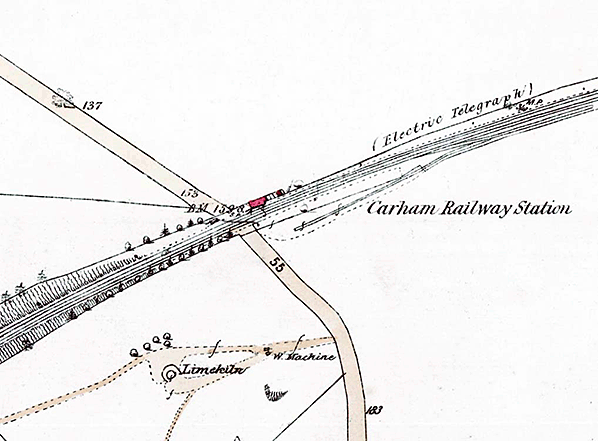 1862 1:2,500 OS map. The platforms are not shown but the station building is indicated (coloured red) immediately north-east of the level crossing, on the up side of the line. A single siding extends south-westwards from the running lines, but the 1898 map indicates that this has been removed.
1862 1:2,500 OS map. The platforms are not shown but the station building is indicated (coloured red) immediately north-east of the level crossing, on the up side of the line. A single siding extends south-westwards from the running lines, but the 1898 map indicates that this has been removed.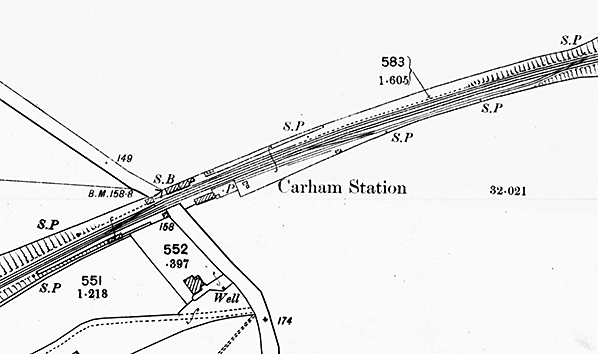
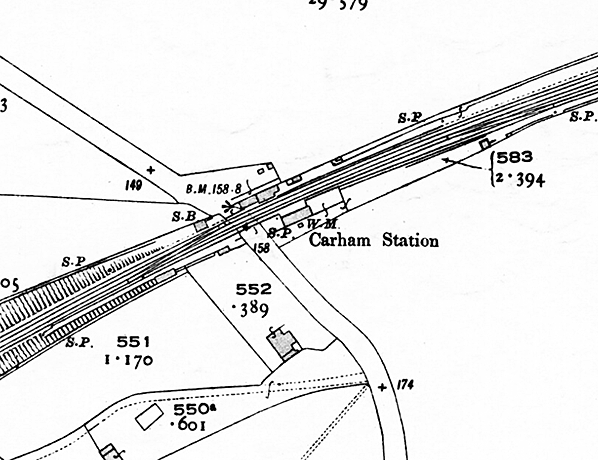
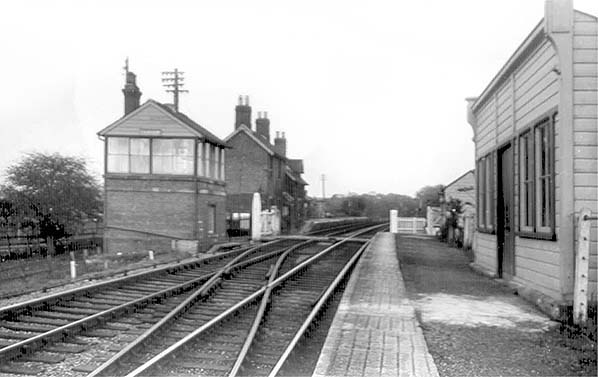

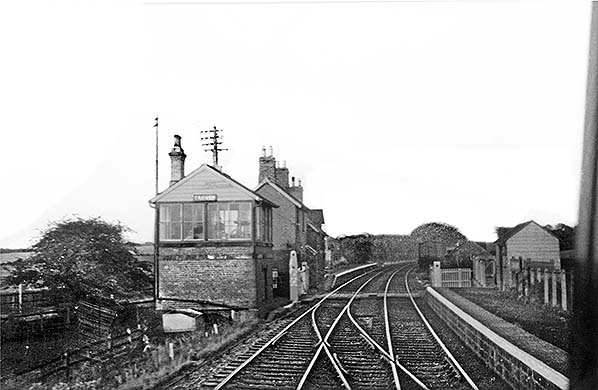
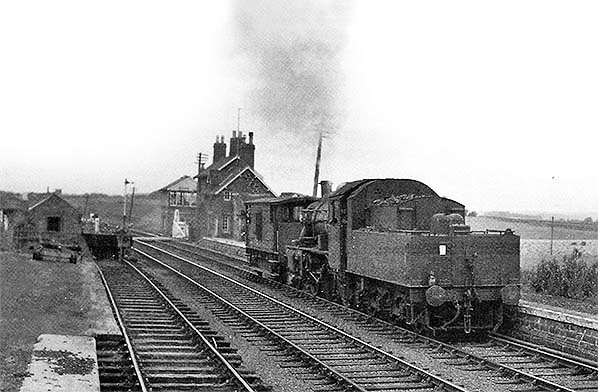

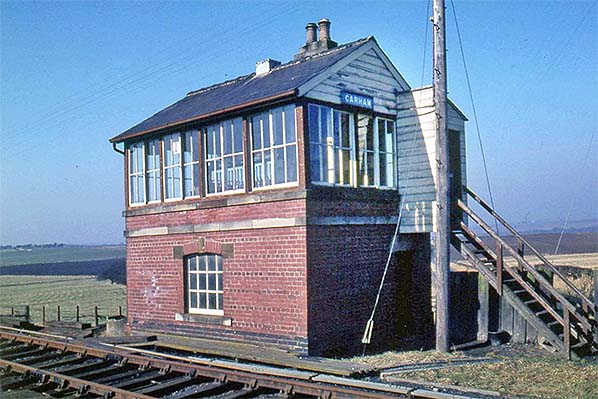

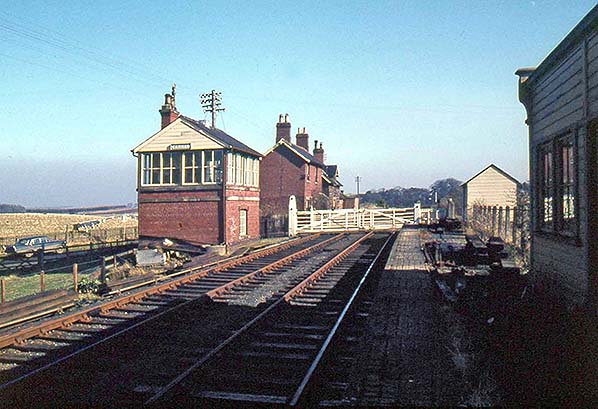 Carham looking north-east along down platform, probably in winter 1963-64. The waiting shelter is seen far right. The signal box is on the up side of the tracks, and beyond the crossing are the stationmaster’s house and the up platform.
Carham looking north-east along down platform, probably in winter 1963-64. The waiting shelter is seen far right. The signal box is on the up side of the tracks, and beyond the crossing are the stationmaster’s house and the up platform. The exact opening date of Carham station is not known. Early railway timetables sometimes failed to identify each station on a route, and Bradshaw of March 1850 gives the train service between ‘Sprouston (Kelso)’ and Tweedmouth in a narrative form with only the times of departure from the two termini stated and no reference to Carham or any other intermediate stations. Departures from Sprouston on weekdays are at 1.15am (stated as 1¼ morn.) – surely a mistake? – and at 2.45 and 6.20pm. On Sunday there are departures at 9.00am and 7.00pm. Quick (2009) suggests that the station opened with the line or very soon after.
The exact opening date of Carham station is not known. Early railway timetables sometimes failed to identify each station on a route, and Bradshaw of March 1850 gives the train service between ‘Sprouston (Kelso)’ and Tweedmouth in a narrative form with only the times of departure from the two termini stated and no reference to Carham or any other intermediate stations. Departures from Sprouston on weekdays are at 1.15am (stated as 1¼ morn.) – surely a mistake? – and at 2.45 and 6.20pm. On Sunday there are departures at 9.00am and 7.00pm. Quick (2009) suggests that the station opened with the line or very soon after. The stationmaster’s house was on the up side, close to the crossing. The platform ramp was set back from the crossing and in front of the house there was a track-level path from the level crossing to the platform. The two-storey house was of smooth but uncoursed stone, with a dormer window facing the platform, adjoined to the south-west by a taller building of simpler design. One house was possibly the residence of the stationmaster and the other of the porter – an arrangement found at some of the large station buildings on the ECML. Whereas at Sunilaws a single-storey office range extended from the station house, at Carham there was a stone-built lean-to. On the down platform, some way from the crossing, stood a timber-built, enclosed waiting shed with a pent roof sloping away from the platform edge. This was a later NER addition, and although bearing a family resemblance to the shelters at Norham and Velvet Hall it was a smaller, more dignified affair than at the other two stations where the accommodation was greater and the lofty roofs looked ungainly. A small, pent-roofed store or shelter stood on this platform, nearer the crossing.
The stationmaster’s house was on the up side, close to the crossing. The platform ramp was set back from the crossing and in front of the house there was a track-level path from the level crossing to the platform. The two-storey house was of smooth but uncoursed stone, with a dormer window facing the platform, adjoined to the south-west by a taller building of simpler design. One house was possibly the residence of the stationmaster and the other of the porter – an arrangement found at some of the large station buildings on the ECML. Whereas at Sunilaws a single-storey office range extended from the station house, at Carham there was a stone-built lean-to. On the down platform, some way from the crossing, stood a timber-built, enclosed waiting shed with a pent roof sloping away from the platform edge. This was a later NER addition, and although bearing a family resemblance to the shelters at Norham and Velvet Hall it was a smaller, more dignified affair than at the other two stations where the accommodation was greater and the lofty roofs looked ungainly. A small, pent-roofed store or shelter stood on this platform, nearer the crossing.
 The Railway Clearing House Handbook (1904) notes that Carham station handled general goods, livestock and horse boxes / prize cattle vans but no crane was provided. The station’s rural hinterland with its mixed farming was reflected in the principal goods dispatched which were barley (316 tons) and 39 wagons of livestock in 1913. No villages stood within the vicinity of the station, and the catchment was estimated to be 682 in 1911; in that year 3,268 tickets were booked.
The Railway Clearing House Handbook (1904) notes that Carham station handled general goods, livestock and horse boxes / prize cattle vans but no crane was provided. The station’s rural hinterland with its mixed farming was reflected in the principal goods dispatched which were barley (316 tons) and 39 wagons of livestock in 1913. No villages stood within the vicinity of the station, and the catchment was estimated to be 682 in 1911; in that year 3,268 tickets were booked.  Carham station served only scattered farmsteads and the diminutive Carham village was at an inconvenient distance. Passenger traffic was never heavy, and in the 1950s it continued to dwindle.
Carham station served only scattered farmsteads and the diminutive Carham village was at an inconvenient distance. Passenger traffic was never heavy, and in the 1950s it continued to dwindle. On Saturday 2 July 1955 the final passenger trains called at Carham station and two days later it officially closed. Goods traffic continued to be handled until 18 May 1964 when the station closed entirely. One month later, on 15 June 1964 the passenger service between Berwick and St Boswells was withdrawn and goods trains on the line between Tweedmouth and Kelso ceased on 29 March 1965; Carham’s signal box was in use until this date. The down rails through the station were removed early in 1966 and the main buildings on the up platform were demolished; photographic evidence suggests that the buildings on the down platform had also been removed by this time. The up rails were lifted in 1969/70. Both platforms and the goods loading bank remain in remarkably good condition half a century after all traffic ceased to use Carham station.
On Saturday 2 July 1955 the final passenger trains called at Carham station and two days later it officially closed. Goods traffic continued to be handled until 18 May 1964 when the station closed entirely. One month later, on 15 June 1964 the passenger service between Berwick and St Boswells was withdrawn and goods trains on the line between Tweedmouth and Kelso ceased on 29 March 1965; Carham’s signal box was in use until this date. The down rails through the station were removed early in 1966 and the main buildings on the up platform were demolished; photographic evidence suggests that the buildings on the down platform had also been removed by this time. The up rails were lifted in 1969/70. Both platforms and the goods loading bank remain in remarkably good condition half a century after all traffic ceased to use Carham station.
 Home Page
Home Page